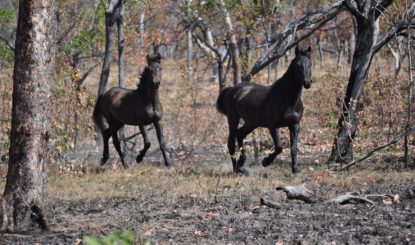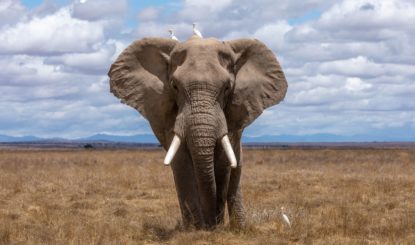In the Paradise of the Brumbies
Thirty years ago, Fondation Franz Weber purchased the old Bonrook cattle ranch in Pine Creek in the far north of Australia and converted it into a wild horse reserve. Sam Forwood, Station Manager of the Franz Weber Territory for almost a quarter of a century now, reports on the wet and dry seasons in the 500-square-kilometre paradise for wild horses and numerous indigenous species.
The wet season that has just finished here on Bonrook was average. It started out with a bang and ended with a whimper. Meaning the early storms in October were very promising, but they petered out in January with only small rainfalls in February and March. We generally get good rains through until April.
The brumbies here on the rangelands do well during the monsoon season regardless if it is a big one with flooding or a poor one. They are used to this and adapt well. During times of flooding you find them living up on the higher ground and on the rocky hillsides. This would account for the fact that their hooves are very hard and always well formed. Rarely, if ever, do you see one of these horses with a hoof defect.
During times when the monsoons are below average, you find the brumbies all across the countryside in family groups. They tend to occupy the rougher, higher ground only when it is a necessity. You will see the mares with their young foals that were born in the months prior to the wet season. Although sometimes it is not so easy to catch a glimpse of the foal, because the mother always shields the little one with her body as soon as she thinks danger is imminent.
Now, in the middle of the dry season, the brumbies enjoy the cooler weather. Many will develop a winter coat that they will shed when the humidity builds again. They range far and wide across all corners of the property and do well on the fresh grass that has come back after the controlled burn-offs. Large family groups are found in the rangelands with the alpha stallion in control of his harem. He keeps his mares all in check and fends off any threats from other stallions. He will also ensure that when the younger males reach maturity that they are pushed out of the harem as to fend for themselves. These young males then form small bachelor groups of usually three to five members and graze and roam together.
When stallions get approached, depending on their temperament, they will either flee, which is their natural defence mechanism as with all horses, or they will circle back and observe you from a distance. They always stand in the shade and mostly behind thick bush. Mares with young foals stay at the rear of the mob, while the stallion and his harem place themselves between the mothers with their young and you. This can make it hard at times to get good photos particularly of the young ones.
At times when you are driving down a bush track a brumby mob will canter along beside you roughly 100 metres out in the scrub and moving parallel. The alpha stallion naturally bringing up the rear and keeping all of his mob in front of him. If it takes their fancy and particularly on cool mornings in the dry season, they will do this for many kilometres. They move at pace through the thick scrub with great agility and far faster than any vehicle or motorbike can travel. Never do you see any of them stumble or become injured even when moving through dense thickets.
During the months of the build-up to the wet season and starting in late September, the mobs will walk great distances from their feeding grounds to water and as such they will lose a little condition and drop in weight. As soon as the rains come and the grass returns, they regain this weight very quickly.
As stated above, at this time of year they are in fine form and fettle: Smooth glossy coats and long manes and tails. The family groups grazing out on the rangelands in the mid-dry season months are quite something to see.
More information:
- Our project page “Wild Horse Sanctuary in Australia”
- This article was first published in the Journal Franz Weber 129. You can find the PDF version of all previous magazines here.
- You have not yet subscribed to the Journal Franz Weber? Order the latest issue for free here (in German and French only).


